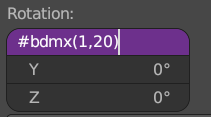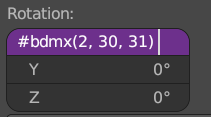Index
DMX512
DMX 512 is a method to control entertainment devices. It works by sending 512 values (these values are called channels, each value (each channel) is a digit between 0 and 255). These channels are sent either over RS485 or over Ethernet network via protocols like sACN or ArtNet. When DMX is sent over Ethernet, each group of 512 channels is called a Universe.
Each controlled device requires certain number of DMX channels, each channel then typically controls one feature of the device, for example dimmer, horizontal panoramic movement (pan) or vertical tilting movement (tilt) and so on. The layout of which channel controls which feature are decided and given by the manufacturer of the device.
Each channel can carry 8bits of information, that is a value between 0-255. Sometimes, more precise control is needed, in that case multiple (typically two) channels are used to form 16bits - being able to carry value between 0-65535.
In order to control or visualize devices, a description of what device features are and how they are mapped to DMX channels is needed, this is where GDTF comes in.
DMX Addressing#
Each fixture needs to have a DMX address. This address is a starting value from which the fixture will be receiving data from the DMX stream and the amount of received data depends on the amount and type of controllable parameters of the fixture. Different types of fixtures typically have different amount of controllable parameters, thus different amount of required DMX channels (often called “DMX footprint”). The addresses thus need to be spaced in such a way that the fixtures and their DMX footprints do not overlap.
As the DMX512 contains 512 channels, it can for example control up to 512 single channel based devices. A Dimmer is a good example of a device which needs just a single channel to be controlled. Each Dimmer will have it’s own address (1-512). If the device is for example LED fixture with RGB colors, each color will be one channel, then this fixture will need 3 channels and one can control up to 170 RGB fixtures on one DMX line (512 total possible channels / 3 channels required by the fixture = 170 fixtures possible to control individually over one DMX line). Each fixture will be addressed in such a way that it’s channels are not overlapping with other fixtures, so for example: 1, 4, 7, 10, 13… More complex devices require more channels, thus more spaced-out addressing.
This was a very quick introduction. You can read more about DMX512 on the web.
DMX Universes and DMX Protocols in BlenderDMX Addon#
A Universe is a group of 512 DMX channels. BlenderDMX Addon supports the following protocols to control the devices:
- BlenderDMX Addon contains a built-in Programmer for Dimmer, Pan, Tilt and more, universe counting starts from 0.
- sACN protocol counts universes from 1, thus the first universe is 1, second 2…
- Art-Net protocol counts universes from 0, thus the first universe is 0, second 1…
BlenderDMX Addon DMX driver for Blender#
ℹ️ There is no need to set this driver up to control patched lighting fixtures as patched fixtures receive DMX automatically.
The BlenderDMX Addon provides a custom DMX driver #bdmx for Blender,
allowing to use received DMX values and use them as input for any Blender
property. To utilize this feature, #bdmx(universe,channels(s)) keyword can be
used, universe is desired universe, channel is an address and it can either
be a single one for 8 bit value or multiple, for 16, 24, 32… bit values.
So to receive 8bit value from universe 1, address 20, this is the syntax:
#bdmx(1, 20):

To receive a 16bit value from universe 2, address 30 and 31, this is the
syntax: #bdmx(2, 30, 31).

The channels can be in any order, depending on how the console is sending it,
for example #bdmx(1, 21, 20):
In order to see 3D objects being animated through this driver, the animation player must be in the “Play animation” state:

See Recording #bdmx driver for information on how the driver data can be recorded to keyframes and then played back.